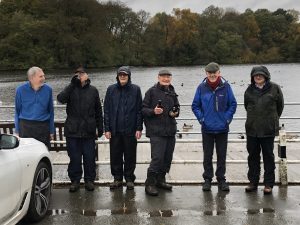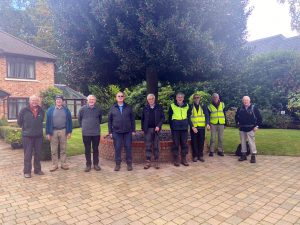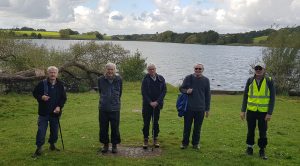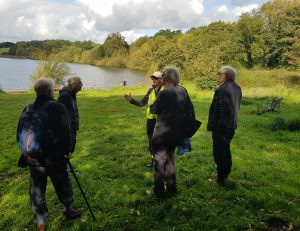Click on Title to Expand
29th October 2020 – Walk- Siddington Area
[Report by Jerry Bentley]

The hardy walkers meet at Reeds Mere
On the instruction of our walk leader Andy Whitaker we met in the morning at the Reeds Mere car park in Siddington. The weather forecast was awful and even before the start the expected nine walkers had been reduced to seven. Seven is itself an unfortunate number in these “interesting times”, so after some assessment of the situation it was decided we would walk as a group of three followed at the appropriate distance by a second group of four with the proviso that “never the twain shall meet”.
Off we went, leaving the multitude of ducks paddling about the car park, across the fields, through the woods around the Mere and on past the sailing club with the rain coming down fairly steadily. It was not ideal walking weather but pity the intrepid angler that we met on the path pushing an outsized wheelbarrow full of gear. He made us look like wimps as he was on his way to spend three days and two nights sitting by the waterside carp fishing – we wished him good luck, whilst silently questioning his sanity and pressed on.
Leaving the Mere behind us we crossed the A34 and walked past Capesthorne Hall before setting out across a series of cow pastures each separated by hedges with numerous stiles. Andy had warned us that the walk was muddy and this part of the route certainly lived up to that billing. It seemed that climbing almost every stile was followed by a paddle through a morass of mud and cow manure to reach firmer ground and still the rain came down.
Fortunately we finally moved onto woodland paths and minor roads passing a charming “Hansel and Gretel” thatched cottage deep in the woods before again crossing the A34 to return to our starting point via Siddington village hall and the adjacent picnic area. Andy was the perfect guide never once showing any signs of not having the route clearly in his mind and even coming up with a short route back as still the rain came down.
A picnic lunch in Siddington had been part of the original plan and although the weather forecast alone had put paid to that idea, Scott had very generously still brought the beer.
So after an enjoyable but “character building”, wet and muddy walk it was time to go home, get changed, put one’s clothes in the washing machine and sit down with a hot cup of tea!
22nd October 2020 – Club Meeting (via Zoom)
There was a Club meeting online using the Zoom application software on Thursday 22nd October. It took the form of a short business session followed by Dick Warwick’s talk on Brunel and the Stephensons. Twenty-four members took part in the meeting, and related to each other informally before and after the meeting. The session was recorded and has been made available for viewing by all Club members. Many members spoke favourably about the experience and it was agreed to hold another Club meeting by Zoom on Thursday 12th November, with an external speaker. Consideration is now being given to reactivating the Discussion Group using Zoom or an alternative computer program.
Speaker, Mr Dick Warwick, who gave a talk entitled ‘The 19th Century Engineering Dynasties – The Brunels and the Stephensons’
Dick started his talk with the Brunel’s family tree, and explained how the French Brunel family became established in Britain, when Marc Isambard Brunel married Sophia Kingdom in 1799. Marc had been a very successful engineer. The machine he developed for making wooden pulley blocks was used right up to the 20th century including for the D-day Normandy landings, and he was also responsible for the Rotherhithe tunnel under the Thames, which is still in use as part of the London Underground Railway.
Marc had two daughters and a son – Isambard Kingdom Brunel. He too was involved with the construction of the Rotherhithe tunnel, and injured his leg escaping when the tunnel flooded. He was part of the Committee tasked with the construction of the Great Exhibition, where he worked with Robert Stephenson. Isambard also built a military hospital, which was shipped out to the Crimea during the Crimean wars.
Dick then focussed on the Stephenson family tree, starting with Robert Stephenson, who married Mabel Carr in 1778. They had six children, including Robert and George. Robert assisted his brother George in the design and construction of many railways, before later becoming a colliery manager. Robert’s son George Robert, inherited the Stephenson locomotive factory, although it was managed by George Robert’s two sons, George and Robert.
George senior made many significant improvements to steam engines. He designed and built steam locomotives and also developed a safety lamp for use in mines. His son, also called Robert, worked in partnership with his father for a number of years, and they were responsible for many miles of railway track in the UK. Stephenson’s first major railway project was the Stockton to Darlington railway, which opened in 1825. The track gauge was set at 4’ 8½″, the same as for wooden tracked wagons.
Numerous other railway projects followed, some of which included tunnels built in areas containing quicksand, and laying track over very difficult terrains.
Stephenson’s locomotive works continued producing steam locomotives until the 1970s.
Brunel’s railway projects, mostly in the South West used a track gauge of 7’. Problems with changing from trains with one gauge to another led to an Act of Parliament in 1846 establishing 4’ 8½″ as the standard gauge for UK railways, except in Ireland, where the standard was set at 5’ 3”. At this time there was 1900 miles of standard gauge track, and only 274 miles of 7’ track. Today, just under 55% of all railways worldwide run on standard gauge track.
Brunel also had many other major projects, some linked with railways, such as the Tamar bridge and the Maidenhead brick-built bridge, both of which still carry trains today. In 1831 he won a competition to build the Clifton suspension bridge, although funding problems delayed its construction until it was finally opened in 1864.
One of the problems with bridge construction in the first part of the 19th century was the weakness of cast iron under tension. Wrought iron was much stronger, but expensive and difficult to make in large quantities. Early designs used wrought iron rods, tubes or a combination of both, to keep the larger cast iron girders in compression. This practice continued until the arrival of mild steel in 1859. Many of these bridges, such as Stephenson’s two-level bridge over the Tyne, are still in use today. The wrought iron top deck carries the lighter traffic, whilst the cast iron lower deck carries the railway track.
Robert Stephenson had two yachts built for him, both were called Titania. It is recorded that he and Isambard Kingdom Brunel dined together on one of these yachts on Christmas day in Cairo. Robert Stephenson also helped to finance the construction of a bulk coal carrying ship, The John Bowes.
Brunel, on the other hand, commissioned the construction of ocean-going passenger steamships, starting with the Great Western. This combined sail and steam powered paddles, and was designed to carry passengers across the Atlantic. She made 47 transatlantic crossings to New York before being sold, and continued in service until she served as a troop ship during the Crimean War. The other ship owned by the Great Western Steamship company was the Great Britain. After running aground off the coast of Ireland, the cost of the repairs caused the company to fail, and both ships were sold. Great Britain’s new owners used her to sail between the UK and Australia for thirty years. Later, as a coal carrying sailing ship a fire forced the ship to dock at the Falkland Islands. The damage was so severe that she served as a bulk storage container at Port Stanley until she was brought back to Bristol and restored as a museum ship. Brunel’s next shipping venture was the Great Eastern. The project was fraught with financial problems and she only made a small number of loss-making voyages before being auctioned. She was finally used as a cable laying ship as her length and paddles made her extremely stable.
Dick concluded his talk by stating that in 1859, Robert Stephenson and Isambard Kingdom Brunel died within a month of each other. He reflected on their achievements, and the times that they had attended each other’s major events. Their legacy can clearly be found, still functioning, in many parts of the world today.
Dick then took questions from an appreciative audience.
15th October 2020 – Walk – Knutsford

Colin Bowman, a stalwart member of the walking group who had led walks on many occasions and introduced new walks to the group, is leaving the area in mid-November for a new life in Devon so that he and his wife Jean can be nearer their children and grandchildren.
In recognition of Colin’s contribution, the walkers decided to treat the walk on 15th October as Colin’s swansong. The plan was a circular walk starting and finishing at the Dysart Arms, Bunbury, part of the walk being along the banks of the Shropshire Union Canal passing Bunbury Watermill and Bunbury Locks. All the arrangements were made well in advance including a recce of the walk and a visit to the Dysart Arms to check out its standard of compliance with Covid-19 precautions.
A few days before the walk there were Government announced changes in lockdown rules for East Cheshire and as we were then unable to have lunch at the Dysart Arms it was concluded that the group should revert to a Knutsford based walk as 45 minutes driving each way was not warranted particularly as car sharing is not allowed.
There were nine walkers, so Colin led a group of six intrepid walkers on a five-mile hike through Toft woods, Seven Sisters Lane, Ollerton, Manor Lane, Toft Woods, and Goughs lane, starting and finishing on Legh Road. Scott Martin led a four-mile walk with two walkers along Chelford Road, Windmill Woods, and Toft Road, Bexton and Paradise Green and back via the “Ways” estate to Legh Road.
Afterwards, the two groups met briefly in Scott’s garden to enjoy a socially distanced beer to wish Colin the best for his new life in Devon. Club Chairman, Jim Flett said a few words saying that we were sorry to see Colin go, we had all benefitted from Colin’s walking knowledge, he had been good company and had set a good pace on the walks and that everyone had appreciated Colin’s support of other walkers during some of the more challenging walks. The Chairman presented Colin with a case of our local Tatton Brewery beers as a memento remarking that it wouldn’t last long once he had opened it once settled in Devon!
8th October 2020 – Annual Probus Golf Competition
[Report by Andy Whittaker]
The annual ‘Probus Masters’ took place at Knutsford Golf Club on the 8th October despite atrocious overnight weather and tight Covid 19 restrictions (which prevented the usual presentations taking place in the clubhouse). This was in large part due to the titanic organisational efforts of Anthony Ellis of Tatton.
Tatton retained the team trophy but Rex came a creditable official joint second with Plumley a few points behind.
Huge congratulations and a big virtual hand to Neil Stott for retaining the individual trophy. Also well played Jack Coleman and Jerry Bentley. Unfortunately due to the sodden conditions (especially the bunkers where sand had turned to heavy mud) and the overhanging branches of some fiendishly placed oak trees, David Howard, Andrew Whitaker (who also missed two 3 foot putts) and David Hartshorn struggled to match our illustrious colleagues. However, it turned out to be a very enjoyable occasion and we are already looking forward to next year’s competition.
8th October 2020 – IT Meeting (via Zoom)
David Howard gave a presentation about printer ink. A recording of the meeting can be found on the members section of the KRPC website. The next Zoom IT meeting will be on Thursday, 12th November, when the subject will be integration – linking smart phones, personal computers and tablets.
1st October 2020 – Walk – Pickmere


Seven – Six go around Pick Mere.
Seven had planned to meet at the Red Lion in Pickmere, to start a walk at 10am sharp led by Jerry Bentley. Come the appointed hour there was no sign of a certain, very senior member of the walking group, nay the Knutsford Rex Probus Club! Calls to his mobile only resulted in the not available signal. No choice but call to his home and his lady wife:
“Where’s X?”
“He’s meeting you at the pub in Pickmere”
“We’re there, but he’s not”
“He must be at the other pub.”
“There’s only one.”
“Oh. Have you tried his mobile?”
“Yes. Its unobtainable”
“Have you got his new number?”
And with the new number, Houston finally made contact with Apollo 18 to be told by Flight Commander X that he was “Totally lost”. At which point communications vanished, permanently. In a last hope, a text was sent into the ether to Apollo 18 somewhere in deepest Cheshire, that ‘we would start the walk at 10:15 hours’, with or without him. Cruel.
So off we went on our heartless way, crossing fields to Wathall Farm and Gravestones Farm returning to the village of Pickmere to set off around Pick Mere itself. Before we set off to circumnavigate the mere, Jerry told us about how there was once a fun fair and rowing boats for hire and a little cruiser called the Princess Irene which used to do pleasure trips around the pool. However, the whole enterprise failed and the cruiser was sung sunk along with the fun fair in the waters deep. For more on this see:
https://www.facebook.com/groups/1007471869307990/
We did meet a youngish couple in wet suits who had been swimming, impressive on the first day of October. That was nothing compared to the two ladies we met after our orbit, who putting not too indelicately, were age qualified to join The Rex.…..easily, in bath robes discreetly towelling themselves dry after what must have been a very bracing swim. After that six mere males skulked their way back to the Red Lion.
There we saw Apollo 18 had landed safely, only to be chastised by Flight Commander X for being late for lunch. “Your round!” he was unanimously told and his round it was. So seven had a good lunch across 2 tables and our thanks go to Jerry for an excellent walk.
By the by, X did sneak a quick walk around the mere after he had gone home and looked up where Pickmere is on Google, so in the end it was ‘Seven Six go around Pick Mere’.
